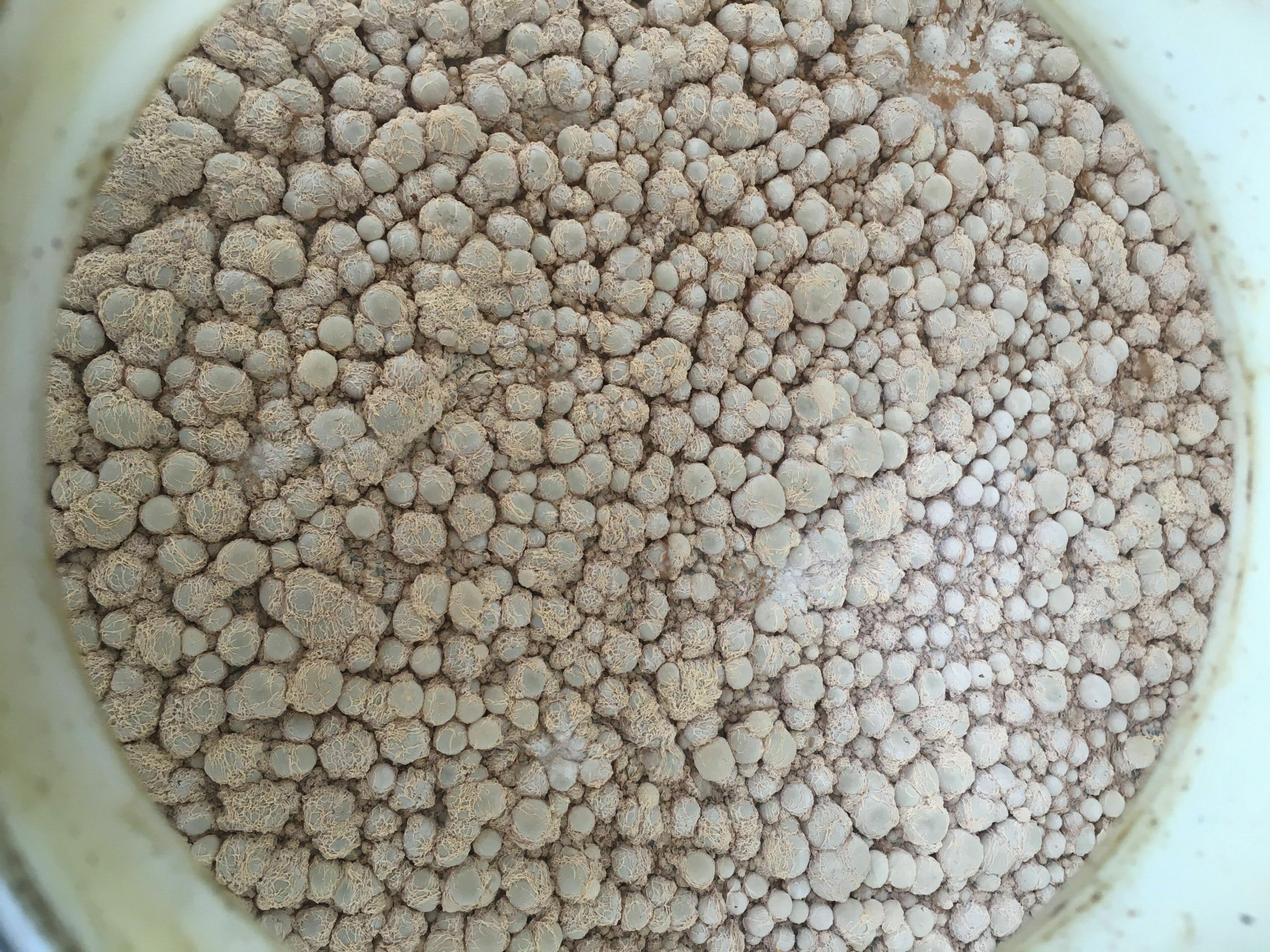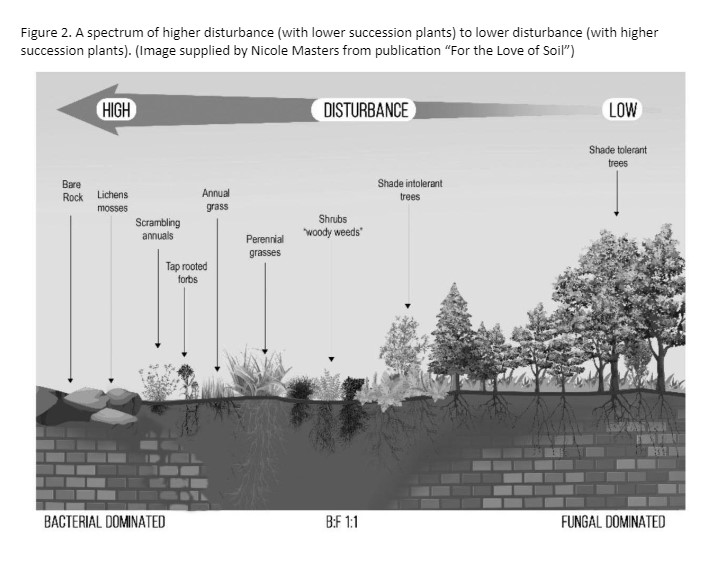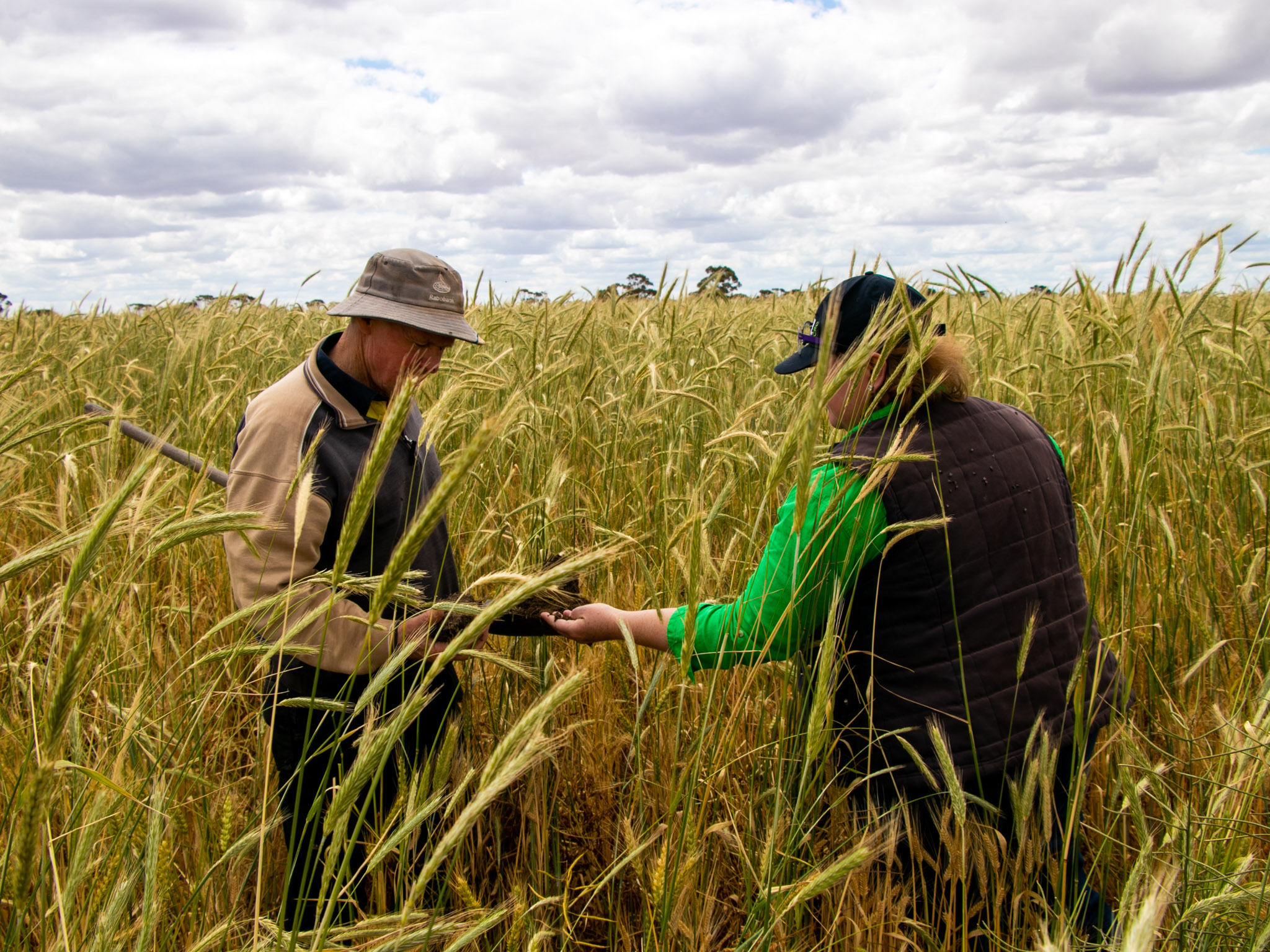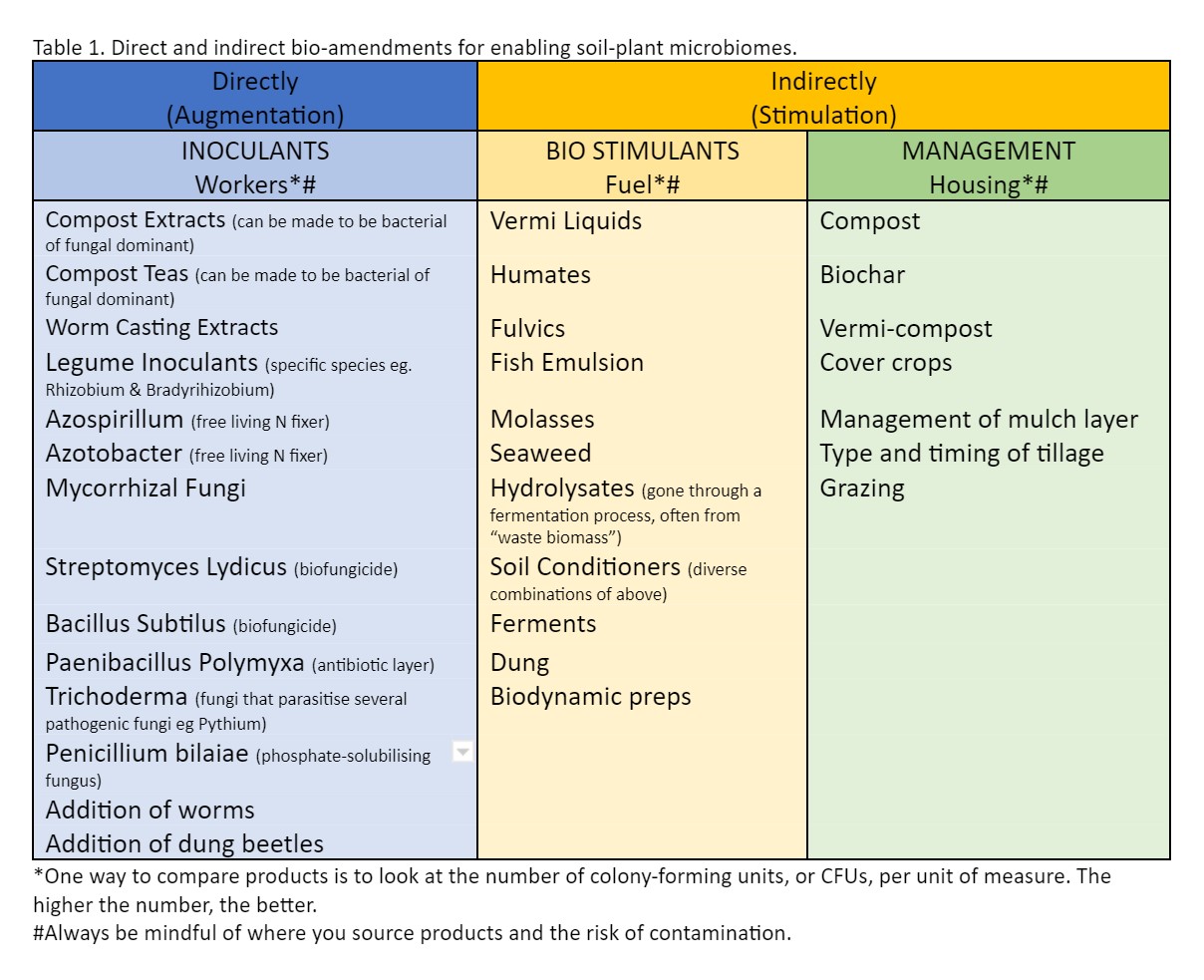Exploring the benefits of
bio-amendments in cropping.
Supporting soil health
All farmers can support thriving soil health. In this article, we introduce basic dynamics of soil microbiomes, and summarise practices and principles that have helped our farmers begin the exciting process of increasing soil health from the microbiome perspective.
Many people are sharing their understanding of how bio-amendments can stimulate the soil-plant microbiome and the dynamics of “quorum sensing”. Quorum sensing describes the microbial community’s ability to sense and respond to signals, both direct and indirect. Why is this important and how are farmers making sense of bio-amendments in cropping? What have been their first steps?

Soil in a multispecies paddock.
Appreciating the soil-plant microbiome
In the soil-plant microbiome, everything has a function, many of which we are yet to fully appreciate. Much of the exchange in energy in the microbiome comes down to classic predator-prey relationships. It’s a feeding frenzy by organisms and by plants. For a very basic example:
- Bacteria need simple sugars, carbohydrates and proteins
- Fungi can eat bacteria, as well as need complex sugars, fats, and proteins
- Protozoa eat bacteria
- Nematodes eat bacteria, fungi, protozoa, and nematodes
- Arthropod/Insects eat of the above and each other.
Did you know that growing root tips can absorb entire microbial cells? This is one very new discovery known as Rhizophagy (“root eating”), where plant roots actually engulf organisms and strip mineral nutrients out of them, then spit them out, so they can go back to work obtaining more nutrients. The work of Dr James White is expanding our understanding in this area.
When the food web gets out of balance, unwanted situations can occur. Many producers are familiar with pathogenic organisms, however pathogens in a healthy soil are seldom a major issue. In functioning soils, pathogens are a helpful part of the food chain. For example, symbiotic endophytes (a plant or fungus which lives inside another plant) can change the behavior of soil-borne pathogens to become beneficial organisms, and provide nutrients to the plant.
Basic dynamics of the soil-plant microbiome
With knowledge of the microbiomes’ unique functions, our case study farmers have embraced management options that lift the diversity and complexity of their microbiomes. Similar to life above ground, essential needs for life below ground, or on and in plant structures must be met from them to thrive.
To imagine how organisms and living processes support essential needs, we use the guiding metaphors of Dr. Neil Wilson, an Australian microbial ecologist. Just like human communities, soil biology needs genetic and cultural diversity (workers), across species of bacteria, fungi, protozoa, nematodes, insects, and more.
In addition, the diverse soil food web communities all need unique forms of air, food and nutrients (fuel); shelter (housing); and care. In the following section, we describe how farmers can meet these essential needs with additives, such as:
- living bacterial inoculants as ‘workers’
- organic bio-stimulants as ‘fuels’
- and management as ‘housing’.
While this reads simply, we acknowledge there is a complex symbiotic relationship between soil and plants that farmers are supporting to function more effectively.
Bio-amendments for influencing the soil-plant microbiome
Considering the unique needs of the diverse soil food web, farmers can use various bio-amendments to stimulate different parts of the soil-plant microbiome. Dr Neil Wilson distinguishes between direct and indirect use of bio-amendments that can shape these microbiomes:
- direct additives are inoculants, or living microbes
- indirect additives are organic materials that provide essential services to the soil microbial herd, such as fuel (bio-stimulants) and housing (organic materials and management practices).
In the following table, we have summarised how farmers can design and influence the soil-plant microbiome through bio-amendments; informed by Dr Wilson’s foundational work and elaborated here by Sarah Fea, with specific examples.

Anaerobic ferment of product increase of ActivFERTs product SoiLIFE. The image shows what the surface to looks like when it’s matured and ready to use.
Linking bio-amendments to growth phases
Timing the integration of bio-amendments within a plant’s life-cycle is important. In the diagram below the key growth phases in wheat cropping are mapped to strategies that can be adopted across each phase to support the soil-plant microbiome. This example does not single out one product or approach, instead the aim is to illustrate some of the considerations for farmers at different points in the growth phase of cropping. For example:
- Soil conditioners in pre-planting or post-harvest
- Pre-planting liquid injection to stabilise fertilisers (down the same slot)
- Seed dressings and inoculants at planting
- Liquid injection at seeding
- Foliar applications guided by either plant brix (refractometer), sap or tissue results that may also include nutrients if required.
Other practices that influence the soil-plant microbiome
In addition to the direct and indirect practices described above, farmers have influence over several other factors that support soil health. Certain factors are outside a farmers’ control, including influences like air pollutants, temperatures, rainfall and fire.
Through observation and soil testing, our cropping farmers are learning how different management practices, and external factors influence microbiome community dynamics. These are guiding their decision making, for example:
- Reducing rates of clear cutting
- Addressing soil compaction
- Modifying applications, locations and types of fertilisers
- Transitioning away from reliance on pesticides and herbicides
- Considering the purpose of tillage (intensity, repetition and timing) and ways to minimise negative impacts (ie. rip and drip; re-planting quickly)
- Selecting crops to manage microbiome dynamics and soil physical issues ie. monoculture, intercropping and multispecies (at least 4 family groups)
- keeping living roots in the soil, and
- the integration of organic matter (timing, type and placement).
Key take-aways for using bio-amendments to improve soil health
In sum, our regenerative agronomist, Sarah Fea, distills and shares here seven take-ways for working with bio-amendments, which she has observed and applied over the last three decades:
Take time
Create the conditions in which beneficial microbes can thrive (because you can’t simply inoculate your way to a healthy soil). Building up slowly, close observation and patience are essential because there is no “silver bullet”. Testing enables you to get a sense of the size of your “biological engine” so you can build your engine size gradually without blowing a gasket and crashing the system!
Recognise the complex functionality of organisms
Organisms can loosely be grouped into either “construction” or “deconstruction” crews. They perform very different, but equally essential functions. The health of a plant and the phase of the plant’s life cycle determines which group of organisms are needed around the root systems and throughout the plant structures.
Consider homegrown products for growing indigenous microbiomes
Take an audit of resources available in your local area for developing homegrown bio-amendments. Working with locally available resources saves you money and is better suited to growing indigenous microbiomes.
Do your homework
Doing your homework on commercial products vs homegrown practices is also important. The science is not conclusive regarding the benefits of off-the-shelf products in terms of their quality, shelf-life and storage. It’s also worth considering the extent to which biology should be commodified and patented.
Stack
The stacking principle aims to encourage maximum diversity of the food web. Combining different bio-amendments stimulates different organisms through supporting and stimulating activity (fuelling the workers). This increased complexity in functional food web organisms delivers enhanced plant nutrition and builds better aggregation, which in turn makes soils more resilient to drought, improving water penetration and retention.
Consider your context
Before considering specific amendments, it’s important to know your own context and be clear on what you want to achieve. Context is critical because horticulture, annual crops and tree crops all require different approaches to soil-plant health based on understanding the composition of elements in the soil-plant microbiome.
Consider landscape succession in relation to bacterial-fungi ratio
Plant succession and level of landscape disturbance are important considerations for farmers (Figure 2). More soil disturbances will always shift soils towards a more bacterial state, whilst a lack of disturbance supports a more fungal state. For example, lower succession crops (ie. broccoli) have more bacterial community and therefore need support with bacterial-feeding foods. Conversely, intensive tillage of broadacre cropping has damaged fungal communities. Therefore, these food webs need feeding from both bacterial and fungal perspectives (as many bacterial species are food for fungi).

Steps forward
The soil-plant microbiome needs support to function effectively. With so many complex interactions at work, it helps to return to the simple metaphor of workers, fuel and housing as building blocks for thriving communities.
In a follow-up article we share insights from our recent round of cropping farmers who work in diverse climatic regions and with different soil types. In every context, recognising what they had available and utilising what was on the farm has been beneficial, along with setting clear priorities and goals. Close observation is important because so often, success comes down to management, sound decision-making and learning from your own experience.
Read Part Two







